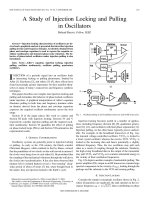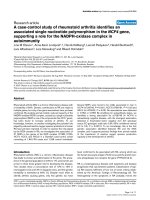Computational study of therapeutic targets and ADME associated proteins and application in drug design
Bạn đang xem bản rút gọn của tài liệu. Xem và tải ngay bản đầy đủ của tài liệu tại đây (1.22 MB, 187 trang )
COMPUTATIONAL STUDY OF THERAPEUTIC
TARGETS AND ADME-ASSOCIATED PROTEINS
AND APPLICATION IN DRUG DESIGN
ZHENG CHANJUAN
(M.Sc. ChongQing Univ.)
A THESIS SUBMITTED FOR THE DEGREE OF
DOCTOR OF PHILOSOPHY
DEPARTMENT OF PHARMACY
NATIONAL UNIVERSITY OF SINGAPORE
2006
Computational study of therapeutic targets and ADME-associated proteins and application in drug design Acknowledgements
- I -
ACKNOWLEDGEMENTS
This thesis would not have been possible to be completed without the kind support,
help, and guidance by lots of people. First of all, I would like to express my deep
gratitude to my thesis advisor Dr. Chen Yuzong. He provides me with the guidance,
support, and encouragement during my years at National University of Singapore. His
advice and insights guided me throughout my doctoral studies. Likewise, his
professional knowledge and kind patience kept me motivated to complete my Ph.D.
thesis. His commentary and counsel I retain in my mind will continue to guide me
through my professional career in future.
Also, I would like to thank my current colleagues and friends for their support and
collaboration in my academic research and daily life: Mr. Yap Chun Wei, Mr. Han
Lianyi, Mr. Lin Honghuang, Mr. Zhou Hao, Mr. Xie Bin, Ms. Cui Juan, Ms. Zhang
Hailei, Ms. Tang Zhiqun, Ms. Jiang Li, Mr. Li Hu, Mr. Ung Choong Yong. We shared
lots of precious experience and happy life in Singapore, which are the treasures in my
life. Although my doctoral study has come to an end, the friendship between us will
remain. In addition, I would also like to thank my former colleagues for their helpful
discussion, advice, guidance and encouragement on my studies and research: Dr. Cao
Zhiwei, Dr. Ji Zhiliang, Dr. Chen Xin, Mr. Wang Jifeng, Ms. Sun Lizhi, Ms. Yao
Lixia, and Dr. Xue Ying.
I would also like to give special thanks to my husband and my parents for their
endless love, support, and encouragement. I dedicate this thesis to them with all my
love.
Computational study of therapeutic targets and ADME-associated proteins and application in drug design Table of Countents
- II -
TABLE OF CONTENTS
ACKNOWLEDGEMENTS I
TABLE OF CONTENTS II
SUMMARY IV
LIST OF TABLES VII
LIST OF FIGURES VIII
ACRONYMS IX
1 Introduction 10
1.1 Overview of target discovery in pharmaceutical research 10
1.1.1 Process of drug discovery 10
1.1.2 Brief introduction to target discovery 11
1.2 Overview of bioinformatics and its role in facilitating drug discovery 13
1.2.1 Brief introduction to bioinformatics 14
1.2.2 Brief introduction to bioinformatics databases 18
1.3 The need for computational study of therapeutic targets and
ADME-associated proteins 21
1.3.1 The need for development of pharmainformatics databases 21
1.3.2 In silico mining of therapeutic targets 26
1.4 Objective and scope of the thesis 27
1.5 Layout of the thesis 29
2 Methodology 31
2.1 Strategy of pharmainformatics database development 31
2.1.1 Preliminary plan of the pharmainformatics database 31
2.1.2 Collection of pharmainformatics database information 32
2.1.3 Organization and structure of pharmainformatics database 33
2.2 Computational methods for the prediction of druggable proteins 39
2.2.1 Introduction to machine learning 39
2.2.2 Introduction to support vector machines 41
2.2.3 The theory and algorithms of support vector machines 42
2.2.4 Model evaluation of support vector machines 45
3 Therapeutic target database and therapeutically relevant multiple-pathways
database development 47
3.1 Therapeutic target database development 47
3.1.1 Preliminary plan of therapeutic target database 47
3.1.2 Collection of therapeutic target information 48
3.1.3 Construction of therapeutic target database 49
3.1.4 Therapeutic target database structure and access 50
3.1.5 Statistics of therapeutic targets database data 55
3.2 Therapeutically relevant multiple-pathways database development 57
3.2.1 Preliminary plan of therapeutically relevant multiple-pathways
database 57
3.2.2 Collection of therapeutically relevant pathway information 58
3.2.3 Construction of therapeutically relevant multiple- pathways database
60
3.2.4 Therapeutically relevant multiple-pathways database structure and
access 61
3.2.5 Statistics of therapeutically relevant multiple-pathways database
data 67
Computational study of therapeutic targets and ADME-associated proteins and application in drug design Table of Countents
- III -
4 Computational analysis of therapeutic targets 69
4.1 Distribution of therapeutic targets with respective disease classes 70
4.1.1 Distribution pattern of successful target 70
4.1.2 Targets for the treatment of diseases in multiple classes 73
4.1.3 Distribution pattern of research targets 75
4.1.4 General distribution pattern of therapeutic targets 76
4.2 Current trends of exploration of therapeutic targets 79
4.2.1 Targets of investigational agents in the US patents approved in
2000-2004 79
4.2.2 Known targets of the FDA approved drugs in 2000-2004 86
4.2.3 Progress and difficulties of target exploration 98
4.2.4 Targets of subtype specific drugs 100
4.3 Characteristics of therapeutic targets 101
4.3.1 What constitutes a therapeutic target? 101
4.3.2 Protein families represented by therapeutic targets 103
4.3.3 Structural folds 105
4.3.4 Biochemical classes 108
4.3.5 Human proteins similar to therapeutic targets 114
4.3.6 Associated pathways 116
4.3.7 Tissue distribution 117
4.3.8 Chromosome locations 118
5 Computer prediction of druggable proteins as a step for facilitating therapeutic
targets discovery 121
5.1 Druggable proteins and therapeutic targets 122
5.2 Prediction of druggable proteins from their sequence 124
5.2.1 “Rules” for guiding the search of druggable proteins 126
5.2.2 Prediction of druggable proteins by a statistical learning method.132
6 Computational analysis of drug ADME- associated proteins 137
6.1 ADME-associated proteins database 138
6.2 ADME-associated proteins database as a resource for facilitating
pharmacogenetics research 141
6.2.1 Information sources of ADME-associated proteins 141
6.2.2 Reported polymorphisms of ADME-associated proteins 145
6.2.3 ADME-associated proteins linked to reported drug response
variations 149
6.2.4 Development of rule-based prediction system 153
6.3 Conclusion 162
7 Conclusion 164
REFERENCES 169
APPENDIX A 184
APPENDIX B 186
Computational study of therapeutic targets and ADME-associated proteins and application in drug design Summary
- IV -
SUMMARY
With the exponential growth of genomic data, the pharmaceutical industry enter the
post-genomic era and adopts a multi-disciplinary strategy is increasingly used to
advance drug discovery. A large variety of specialties and general-purpose
bioinformatics databases have been developed to store, organize and manage vast
amounts of biomedical and genomic data. The first aim of this thesis is to develop or
update three pharmainformatics databases: Therapeutic Target Database (TTD),
Therapeutically Relevant Multiple Pathways (TRMP) database, and
ADME-Associated Proteins (ADME-AP) database. These databases may serve as the
basis for further knowledge discovery in drug target search analysis; drug
pharmacokinetics and pharmacogenetics studies; and drug design and testing.
TTD ( may be the world’s first public
resource for providing comprehensive information about the reported targets of
marketed and investigational drugs. There is a significant increase from that of ~500
targets reported in a 1996 survey [1] to 1,535 targets in latest TTD version, indicating
that more therapeutic targets and related information recorded in recent publications.
This part of work is important for laying the foundations to more advanced studies
about therapeutic targets. By using similar developing strategies, a database of known
therapeutically relevant multiple pathways (TRMP,
trmp.asp), was developed to facilitate a comprehensive understanding of the
relationship between different targets of the same disease and also to facilitate
mechanistic study of drug actions. It contains multiple and individual pathways
information, and also include those relevant targets, disease, drugs information.
Moreover, a new version of another pharmainformatics database, ADME-AP database
Computational study of therapeutic targets and ADME-associated proteins and application in drug design Summary
- V -
( has been updated in this work. A
great number of polymorphisms and drug response information have been integrated
into the old version. By analysis of this kind of information, we assess the usefulness
of the relevant information for facilitating pharmacogenetic prediction of drug
responses, and discuss computational methods used for predicting individual
variations of drug responses from the polymorphisms of ADME-APs.
With the completion of human genome sequencing and the rapid development of
numerous computational approaches; continuous effort and increasing interest have
been directed at the search of new targets, which has led to the identification of a
growing number of new targets as well as the exploration of known targets. As a
result, the second aim of this thesis is to carry out a computational study of
therapeutic targets.
Firstly, the progress of target exploration is studied and some characteristics of
currently explored targets, including their sequence, family representation, pathway
association, tissue distribution, genome location are analyzed. Moreover, from these
target features, some simple rules can be derived for facilitating the search of
druggable proteins and for estimating the level of difficulty of their exploration,
including (1) Protein is from one of the limited number of target families; (2)
Sequence variation between protein’s drug-binding domain and those of the human
proteins in the same family allows differential binding of a “rule-of-five” molecule; (3)
Protein preferably has less than 15 human similarity proteins outside its family (HSP);
(4) Protein is preferably involved in no more than 3 human pathways (HP); (5) For
organ or tissue specific diseases, protein is preferably distributed in no more than 5
human tissues (HT); (6) A higher number of HSP, HP and HT does not preclude the
Computational study of therapeutic targets and ADME-associated proteins and application in drug design Summary
- VI -
protein as a potential target, it statistically increases the chance of undesirable
interferences and the level of difficulty for finding viable drugs. The results indicate
that some simple rules can be derived for facilitating the search of druggable proteins
and for estimating the level of difficulty of their exploration.
Secondly, to test the feasibilities of target identification by using Artificial Intelligent
(AI) methods from protein sequence, an AI system is trained by using sequence
derived physicochemical properties of the known targets. Furthermore, this prediction
system is evaluated by using 5-fold cross validation and scanning human, yeast, and
HIV genomes. The prediction results are consistent with previous studies of these
genomes, which suggest that AI methods such as Support Vector Machines (SVMs)
may be potentially useful for facilitating genome search of druggable proteins. With
more biomedical data added in, the preliminary prediction system of druggable
proteins will be extended and consolidated for speeding up the process of drug
discovery.
Computational study of therapeutic targets and ADME-associated proteins and application in drug design List of Tables
- VII -
LIST OF TABLES
Table 1-1: A brief history of bioinformatics 15
Table 1-2: The biological information space as of Feb 11th, 2005 17
Table 2-1: Entry ID list table 38
Table 2-2: Main information table 38
Table 2-3: Data type table 38
Table 2-4: Reference information table 38
Table 3-1: Therapeutic target ID list table 50
Table 3-2: Target main information table 50
Table 3-3: Data type table 50
Table 3-4: Reference information table 50
Table 3-5: Disease class and associated diseases 52
Table 3-6: Drug classification listed in TTD 53
Table 3-7: Pathway related protein ID table 61
Table 3-8: Pathway related protein main information table 61
Table 3-9: Data type table 61
Table 3-10: Multiple pathways and corresponding individual pathways 63
Table 3-11: Therapeutically relevant multiple pathways related disease or conditions
64
Table 4-1: Number of successful targets in different disease classes 72
Table 4-2: Distinct research target distribution in different disease classes 76
Table 4-3: Some of the successful targets explored for the new investigational agents
described in the US patents approved in 2000-2004. 80
Table 4-4: Research targets explored for the new investigational agents described in
the US patents approved in 2000-2004 83
Table 4-5: Known therapeutic targets of the FDA approved drugs in 2000-2004. There
are a total of 66 targets targeted by 100 approved drugs 87
Table 4-6: Structural folds represented by successful targets. Structural folds are from
the SCOP database 107
Table 4-7: Statistics of the number of human similarity proteins of successful targets
that are outside the protein family of the respective target 115
Table 4-8: Statistics of the number of pathways of successful targets 117
Table 4-9: Statistics of the human tissue distribution pattern of successful targets 118
Table 5-1: Statistics of the characteristics of successful targets 128
Table 5-2: Profiles of some innovative targets of the FDA approved drugs since 1994
131
Table 5-3: Comparison of the known HIV-1 protein targets and the SVM predicted
druggable proteins in the NCBI HIV-1 genome entry NC_001802 136
Table 6-1: Summary of web-resources of ADME-related proteins 142
Table 6-2: Examples of ADME-associated proteins with reported polymorphisms 146
Table 6-3: Examples of ADME-associated proteins linked to reported cases of
individual variations in drug response 150
Table 6-4: Prediction of specific drug responses from the polymorphisms of ADME
associated proteins by using simple rules 156
Table 6-5: Statistical analysis and statistical learning methods used for
pharmacogenetic prediction of drug responses 159
Computational study of therapeutic targets and ADME-associated proteins and application in drug design List of Figures
- VIII -
LIST OF FIGURES
Figure 1-1: Overview of drug discovery process 11
Figure 1-2: Primary public domain bioinformatics servers 18
Figure 1-3: Molecular biology database collection in NAR (1999~2005) 20
Figure 2-1: The Hierarchical Data Model 35
Figure 2-2: The Network Data Model 36
Figure 2-3: The Relational Data Model 36
Figure 2-4: Logical view of the database 39
Figure 2-5: Separating hyperplanes in SVMs (the circular dots and square dots
represent samples of class -1 and class +1, respectively.) 42
Figure 2-6: Construction of hyperplane in linear SVMs (the circular dots and square
dots represent samples of class -1 and class +1, respectively.) 44
Figure 3-1: The web interface of TTD. Five types of search mode are supported 51
Figure 3-2: Interface of a search result on TTD 53
Figure 3-3: Interface of the detailed information of target in TTD 54
Figure 3-4: Interface of the detailed information of target related US patent in TTD.55
Figure 3-5: Interface of the ligand detailed information in TTD 55
Figure 3-6: Comparison between old and new version of TTD data 56
Figure 3-7: Web interface of TRMP database 62
Figure 3-8: Interface of a multiple pathways entry of TRMP database 65
Figure 3-9: Interface of a target entry of TRMP database 66
Figure 4-1: Distribution of therapeutic targets against disease classes 78
Figure 4-2: Distribution of successful targets with respect to different biochemical
classes 108
Figure 4-3: Distribution of research targets with respect to different biochemical
classes 109
Figure 4-4: Distribution of enzyme targets with respect enzyme families 112
Figure 4-5: Distribution patterns of human therapeutic targets in 23 human
chromosomes (For each chromosome, the pattern of successful targets is given on
the left and that of research targets is given on the right.) 120
Figure 5-1: Definition of potential drug targets 122
Figure 5-2: Estimated number of drug targets 123
Figure 5-3: Flow chart about how to facilitate drug target discovery 124
Figure 6-1: Web-interface of a protein entry of ADME-AP database 139
Figure 6-2: Web-interface of a polymorphism 139
Figure 6-3: The detailed information of selected ADME-associated protein 139
Figure 6-4: The flow chart of development of rule-based prediction system 154
Computational study of therapeutic targets and ADME-associated proteins and application in drug design Acronyms
- IX -
ACRONYMS
ABC ATP-Binding Cassette
ADME Absorption, Distribution, Metabolism and Excretion
ADME-AP ADME-Associated Proteins
ADR Drug Adverse Reaction
AI Artificial Intelligent
ANN artificial neural networks
CBI Center for Information Biology
CYP Cytochrome P450
DA Discriminant Analysis
DBMS Database Management System
EBI European Bioinformatics Institute
EMBL European Molecular Biology Laboratory
FDA Food and Drug Administration
GPCR G-protein coupled receptor
HGP Human Genome Project
HP Human Pathways
HSP Human Similarity Proteins
HT Human Ttissues
HUGO Human Genome Organization
KEGG Kyoto Encyclopedia of Genes and Genomes database
MBD Molecular Biology Database
MMPs Matrix Metalloproteinases
NAR Nucleic Acids Research
NCBI National Center for Biotechnology Information
NIH National Institutes of Health
OODB Object-Oriented Database
OOPL Object-Oriented Programming Language
OSH Optimal Separation Hyperplane
PDB Protein Data Bank
SIB Swiss Institute of Bioinformatics
SNP Single-Nucleotide Polymorphisms
SQL Structured Query Language
SRM Structural Risk Minimization
SVMs Support Vector Machines
TCDB Transporter Classification Database
TET Target Exploration Time
TRMP Therapeutically Relevant Multiple Pathways
TTD Therapeutic Target Database
VC Vapnik-Chervonenkis
WHO World Health Organization
Chapter 1 Introduction
- 10 -
1 Introduction
1.1 Overview of target discovery in pharmaceutical
research
Due to the modern life style, an increasing number of people are suffering from
various health problems. How to deal with those problems has become the research
focus of many biomedical scientists in both academic and pharmaceutical industry [2].
Thus, most scientists pay close attention to drug discovery. It is generally agreed that
finding effective drugs for specific disease is an essential way to solve the health
problems [2]. In addition, with the advent of molecular biology, the completion of
human genome project and the rapid development of numerous computational
approaches, more innovative biological concepts and technologies have been
introduced into drug discovery [3-5]. These innovations are essential for constructing
modern drug discovery programs in which target discovery plays an important role
[3].
1.1.1 Process of drug discovery
Drug development is generally a long, costly and uncertain process. Figure 1-1
illustrates the process of drug discovery, which can be roughly divided into two
phases [6]. One is the early pharmaceutical research phase and the other is the late
phase. The former mainly comprises preliminary investigations, target discovery and
lead discovery. The latter consists of preclinical and clinical evaluation. According to
the Tufts Center for the study of drug development (November, 2001), by using
traditional drug discovery methods, developing a new marketed drug takes 10-15
years, and spends about $800 million USD.
Chapter 1 Introduction
- 11 -
Figure 1-1: Overview of drug discovery process [6]
How to efficiently reduce the cost and the time of drug discovery is a major task of
current research. As revealed by Figure 1-1, at certain drug design stages, the use of
computational technologies would be a feasible way to solve this problem. Moreover,
most drug discovery activities begin with target discovery, which involve the
identification and early validation of disease modifying targets. Therefore,
computational study of the target characteristics and developing computer target
prediction methods are significant for understanding the mechanism of drug action
and thus speeding up new target discovery [3, 7].
1.1.2 Brief introduction to target discovery
Generally, target discovery includes two parts: target identification and target
validation [6]. Target identification attempts to find new targets, normally proteins,
which can be modulated by modulators, such as small molecules and peptides, and
thus inhibit or reverse disease progression. For target validation, it plays a crucial role
in demonstrating the function of potential targets in the disease phenotype. The
various techniques applied to target discovery can be grouped into two broad
strategies: system and molecular approaches [8]. In terms of system approach, the
Target
identification
Target
validation
Lead
optimization
Lead
identification
Drug
candidates
Target
Discovery
Preclinical
Testin
g
Clinical
Trials
Market
Earl
y
p
harmaceutical research Late
p
harmaceutical research
Lead
Discovery
Preliminary
Investigations
Technology is impacting this process
Chapter 1 Introduction
- 12 -
focus is on the study of disease in whole organisms. The information used in this
approach is derived from the clinical science and in vivo animal studies. Thus the
system approach has traditionally been the primary target discovery strategy in drug
discovery. By contrast, molecular approach attempts to identify the novel targets
through an understanding of the cellular mechanisms. This approach has been driven
by the development of molecular biology, genomics and proteomics in recent decades.
As a result, it has become an important strategy in modern target discovery.
1.1.2.1 Traditional target discovery
Historically, traditional target discovery, in which classical system approaches are
usually used, predominated in the 1950s and 1960s [9]. To date, it is still relevant for
many disease cases in which the related disease phenotypes can only be detected in
the organism, such as some complex diseases responsible for phenotypic differences
in genetically identical organisms [10]. In traditional routes, therapeutic target
identification is just performed in two ways, either from randomly screening possible
targets known or from clues given by traditional remedies [9]. Obviously, finding a
good therapeutic target only by chance or experience makes target identification
uncertain and inefficient. In addition, traditional target validation relies predominantly
on experimental work in the laboratory by studying animal models in vivo. This is
also a long-term work and needs continuous investment. Since the whole traditional
process is expensive and time-consuming, construction of new modern target
discovery system has become an urgent focus in drug research and development.
1.1.2.2 Modern target discovery
Since the late 1990s, as new molecular biology, especially genomic science, novel
Chapter 1 Introduction
- 13 -
genetic techniques, bioinformatics tools and in silico analysis have been integrated
into drug research and development. Target discovery has gradually become a
cross-disciplinary science, driven not only by biomedical science, pharmacology and
chemistry but also by computational technology [4]. In modern target discovery,
scientists mainly focus on specific molecular targets encoded by disease related
essential genes of known sequence with novel, proven physiological function [5].
Instead of following traditional routes, in which an animal model of disease to yield a
target is applied, current target discovery takes advantage of genomics data and
bioinformatics techniques. For instance, the genomics information of therapeutic
targets is analyzed by computational approaches from which useful information is
generated, which is applied to improve the process of target discovery and ultimately
to reduce the cost and time needed for drug discovery.
1.2 Overview of bioinformatics and its role in
facilitating drug discovery
In 1988, the Human Genome organization (HUGO), an international organization of
scientists involved in Human Genome Project, was founded. Just two years later, the
Human Genome Project (HGP) was started. By referring to the international 13-year
effort, this project was completed in 2003 successfully. All of the estimated
20,000-25,000 human genes were discovered and made accessible for further
biological study. In addition, another goal of HGP, determination of the complete
sequence of the 3 billion DNA subunits (bases in the human genome), is currently
under way.
Undoubtedly, the completed human genome sequence, a grand achievement of HGP,
provides tremendous opportunities for pharmaceutical research. Despite the
Chapter 1 Introduction
- 14 -
opportunities, there are many challenges, such as identifying the genes
(protein-coding regions, structural RNAs, enzymatic RNAs and regulatory sequences)
and other functional fragments (DNA-binding sites, promoters, termination sites, etc.)
from the vast raw genome sequence, understanding physiological function of the
proteins or peptides coded by those genes, correlating disease states to certain genes
and figuring out the potential protein-protein interactions and their pathways in
various situations including pathological conditions. So many promising challenges
excite everyone in post-genomic era. However, the problem is that a vast amount of
biological data has been generated by mapping human genome. Now, more than ever,
scientists need sophisticated computational techniques to store, organize, manage, and
analyze these genomic data, which belongs to a new discipline named bioinformatics.
1.2.1 Brief introduction to bioinformatics
Bioinformatics is an interdisciplinary research area that crosses between biology,
computer science, physics, mathematics and statistics. As described by National
Institutes of Health (NIH), bioinformatics is the “research, development, or
application of computational tools and approaches for expanding the use of biological,
medical, behavioral or health data, including those to acquire, store, organize, archive,
analyze, or visualize such data” [11]. In brief, bioinformatics are used to “address
problems related to the storage, retrieval and analysis of information about biological
structure, sequence and function” [12]. Even if bioinformatics is a new term, some of
the major events in bioinformatics occurred long before it was coined. Generally, the
development of bioinformatics passed through several phases (Table 1-1).
Chapter 1 Introduction
- 15 -
Table 1-1: A brief history of bioinformatics
Phases Important events Year
Before
1950s
Gregory Mendel: “Genetic inheritance” theory 1865
Alfred Day Hershey & Martha Chase: Proving that DNA alone carries genetic information 1952
Watson&Crick: Proposing the double helix model for DNA based x-ray data obtained by
Franklin & Wilkins
1953
Perutz's group: Developing heavy atom methods to solve the phase problem in protein
crystallography
1954
1950s
Frederick Sanger: analyzing the sequence of the first protein “bovine insulin” 1955
Sidney Brenner, Franšois Jacob, Matthew Meselson: identifying messenger RNA 1961
Pauling: theory of molecular evolution 1962
Margaret Dayhoff: Atlas of Protein Sequences 1965
1960s
The ARPANET: created by linking computers at Standford and UCLA 1969
Needleman-Wunsch algorithm developed: sequence comparison 1970
Paul Berg’s group: creating the first recombinant DNA molecule 1972
The Brookhaven Protein DataBank is announced 1973
Vint Cerf & Robert Khan: developing the concept of connecting networks of computers into
an "internet" and developing the Transmission Control Protocol (TCP)
1974
Bill Gates and Paul Allen: Microsoft Corporation (Popularization of personal computers
from 1980s)
1975
P.H.O'Farrel: Two-dimensional electrophoresis, where separation of proteins on SDS
polyacrylamide gel is combined with separation according to isoelectric points.
1975
1970s
Staden: DNA sequencing and software to analyze it 1977
Smith-Waterman algorithm developed 1981
Doolittle: The concept of a sequence motif 1981
GenBank 1982
Phage lambda genome sequenced 1982
Wilbur-Lipman algorithm developed: Sequence database searching algorithm 1983
FASTP/FASTN: fast sequence similarity searching 1985
The Human Genome Organization (HUGO) founded 1988
National Center for Biotechnology Information (NCBI) created at NIH/NLM 1988
EMBnet network for database distribution 1988
Pearson and Lupman: The FASTA algorithm for sequence comparison 1988
1980s
The genetics Computer Group (GCG) becomes a private company. 1989
The Human Genome Project: Mapping and sequencing the Human Genome 1990
Altschul,et.al.: The BLAST program for fast sequence similarity searching 1990
ESTs: expressed sequence tag sequencing 1991
The research institute in Geneva (CERN): announcing the creation of the protocols which
make -up the World Wide Web.
1991
Sanger Centre, Hinxton, UK 1993
EMBL European Bioinformatics Institute, Hinxton, UK 1994
Netscape Communications Corporation founded and releases Naviagator, the commercial
version of NCSA's Mozilla.
1994
Attwood and Beck: The PRINTS database of protein motifs 1994
First bacterial genomes completely sequenced: Haemophilus influenza genome (1.8 Mb)
and Mycoplasma genitalium genome
1995
Yeast genome completely sequenced: Saccharomyces cerevisiae (baker's yeast, 12.1 Mb) 1996
Bairoch, et.al.: The prosite database 1996
Affymetrix produces the first commercial DNA chips 1996
PSI-BLAST 1997
The genome for E.coli (4.7 Mbp) is published 1997
deCode genetics publishes a paper that described the location of the FET1 gene, which is
responsible for familial essential tremor, on chromosome 13 (Nature Genetics).
1997
Worm (multicellular) genome completely sequenced 1998
The genomes for Caenorhabitis elegans and baker's yeast are published 1998
1990s
The Swiss Institute of Bioinformatics 1998
Chapter 1 Introduction
- 16 -
First Human Chromosome 22 to be sequenced: Human Chromosome 22 completed 1999
Fly genome completely sequenced 1999
deCode genetics maps the gene linked to pre-eclampsia as a locus on chromosome 2p13. 1999
Jeong H, Tombor B, Albert R, Oltvai ZN, Barabasi AL: The large-scale organization of
metabolic networks
2000
Drosophila genome completed: D.melanogaster genome (180 Mb) 2000
The genome for Pseudomonas aeruginosa (6.3 Mbp) is published 2000
Draft Sequences of Human Chromosomes 5, 16, 19 Completed 2000
Human Chromosome 21 Completed 2000
The completion of a "working draft" DNA sequence of the human genome 2000
The initial analysis of the working draft of the human genome sequence 2001
Human Chromosome 20 Completed 2001
Draft sequence of Fugu rubripes 2002
Draft sequence of mouse genome 2002
Human genome project completion (1990-2003) 2003
Human Chromosome 14, Y, 7, 6 Completed 2003
Human Chromosome 13, 19, 10, 9, 5 Completed 2004
Human Gene count estimates changed from 20,000 to 25,000 2004
2000s
… …
The entries in Table 1-1 shows that the most significant progress in bioinformatics has
been made remarkably in the last thirty years. With the invention of various sequence
retrieval methods in 1970-80s, increasingly sophisticated sequence alignment
algorithms were developed. In 1980s, scientists used computational tools to predict
RNA secondary structure, and then began to predict protein secondary structure or 3D
structure. In addition, the FASTA for sequence comparison and BLAST algorithm for
fast sequence similarity searching were published in 1980-90s and they dramatically
impelled the bioinformatics forward. Since 1990, many of new biotechnologies,
including automatic sequencing, DNA chips, protein identification, mass
spectrometers, etc., have been applied more and more widely. Numerous biological
data have been produced continuously. Furthermore, large quantities of sequence data
have also been generated by mapping and sequencing genomes of the human and
other species. Table 1-2 gives some examples about the statistic data of the biological
information space as of Feb 2005.
Chapter 1 Introduction
- 17 -
Table 1-2: The biological information space as of Feb 11th, 2005
Type of information Number of entries/records
Nucleotides 44,575,745,176
Nucleotide records 49,127,925
Protein sequences 5,785,962
3D structures in PDB 28,905
BIND Interactions 134,886
Human Unigene Cluster 52,888
Completed Genome project 238
Different taxonomy Nodes 249,219
dbSNP records 18,883,945
RefSeq Genomic records 180,770
RefSeq RNA Records 352,275
RefSeq Protein Records 1,310,899
GenSAT images 98,680
GEO profiles 11,288,275
Homologene gene 38,137
PubChem compounds 897,246
PubMed records 15,382,675
PubMed Central records 341,602
OMIM records 16,521
Obviously, it is impossible to deal with these data manually. These huge data sets
contain vital information for quantitative study of biology which is expected to
revolutionize biology and medical research. On the one hand, the biology and
medicine should not only be treated as specific biochemical technologies, but also as
an information science. On the other hand, as more biological information becomes
available and laboratory equipment becomes more automated, it is necessary to
explore the use of computers and computational methods for facilitating experimental
design, data analysis, simulation and prediction of biological phenomena and
processes. Meanwhile, the use of computational methods can also improve the speed
and efficacy, and reduce the cost of experimental studies.
At present, there are three primary public domain bioinformatics servers (Figure 1-2):
National Center for Biotechnology Information (NCBI: .
gov/), European Bioinformatics Institute (EBI: and Center for
Information Biology (CBI: Basically, each server
Chapter 1 Introduction
- 18 -
performs two parts of task. One is to develop and provide databases to efficiently
store and manage data. The other is to invent useful bioinformatics algorithms and
tools to analyze the data and generate new knowledge for biological and medical use.
With the exponential growth of sequences, structures, and literature, bioinformatics
databases are playing an increasingly crucial role in biological data management and
knowledge discovery [13-16].
Figure 1-2: Primary public domain bioinformatics servers
1.2.2 Brief introduction to bioinformatics databases
Bioinformatics is the science of using information to understand biology [17]. The
core of bioinformatics is the organization of information into databases.
Bioinformatics database is an organized, integrated and shared collection of logically
related bioinformatics data, which represent any meaningful objects and events in life
science. These data can be transformed into information through data modeling, and
thus provide useful knowledge to viewers.
Entrez
Databases: GenBank…
Analysis Tools
SRS
Databases: EMBL…
Analysis Tools
Getentry
Databases: DDBJ…
A
nal
y
sis Tools
National Center for Biotechnology
Information (NCBI) United States
European Bioinformatics Institute
(EBI) United Kingdom (European)
Center for Information Biology (CIB)
Genome Net (KEGG & DDBJ) Japan
NIH
EMBL NIG
Public Domain Bioinformatics
Facilities
Chapter 1 Introduction
- 19 -
Historically, the first bioinformatics database was established a few years after the
first protein sequences became available. The first protein sequence (bovine insulin)
was reported by Frederick Sanger at the end of 1950s [18]. It just consists of 51
residues. In 1963, the first tRNA molecule to be sequenced was the yeast alanine
tRNA with 77 bases by Robert Holley and co-workers [19]. After that, Margaret
Dayhoff gathered all the available sequence data to create the first bioinformatics
database–Atlas of Protein Sequence and Structure [20-22], which is the origin of
PIR-International Protein Sequence Database [23]. The Brookhaven National
Laboratory’s Protein Data Bank (PDB) followed in 1972 with a collection of the
X-ray crystallographic protein structures [24] and it was considered as the first
bioinformatics database, which stored and managed 3D protein structure data by using
computational and mathematical techniques. In 1980s, due to the invention of
automated DNA sequencing technology, the exponential growth of large quantities of
DNA sequence data and associated knowledge came into being, and finally became
the significant driving force for the development of bioinformatics database. The
biological data and knowledge needs to be stored in a computationally amenable form,
which can be shared by the bioinformatics community for both humans and
computers. The Swiss-Prot, an important annotated protein sequence database, was
established in 1986 and maintained collaboratively, since 1987, by the group of Amos
Bairoch first at the Department of Medical Biochemistry of the University of Geneva
and now at the Swiss Institute of Bioinformatics (SIB) and the European Molecular
Biology Laboratory (EMBL) Data Library [25].
Subsequently, a huge variety of diverse bioinformatics databases have been growing
either in the public domain or commercial third parties. Figure 1-3 summarizes the
development trend of Molecular Biology Database (MBD) collected by Nucleic Acids
Chapter 1 Introduction
- 20 -
Research from 1999 to 2005. In comparison with 202 MBDs in 1999, the total
number of MBD in 2005 was 719. It was about 3.5 times than that of in 1999 and the
increase rate reached 256%. The data indicates that the development of MBD is likely
to have a continuous upward tendency in the following years. According to the latest
database issue of Nucleic Acids Research (NAR) [26], to date, more than 700
different databases covering diverse areas of biological research, including sequence,
structure, genetics, genomes, proteomics, intermolecular interactions, pathways,
diseases, microarray data and other gene expression information.
202
226
280
339
422
548
719
0
100
200
300
400
500
600
700
800
1234567
Year
Number of Molecular biolog
y
database
1999 2000 2001 2002 2003 2004 2005
Figure 1-3: Molecular biology database collection in NAR (1999~2005) [26]
On the basis of the scope of databases, a biological database can be grouped into three
categories [27]: general biological databases, which store the raw data of
DNA/protein sequence, structure, biological and medical literature; derived databases,
whose data are derived from the general biological databases, however, contain novel
information; and subject-specialized databases, which collect individual, specialized
information for the communities of particular interests. Besides the diverse area
Chapter 1 Introduction
- 21 -
covered by different kinds of bioinformatics databases, the application of biological
databases is broad, both in the academia and industries. In our research, three
pharmainformatics
*
databases: Therapeutic Target Database (TTD), Therapeutically
Relevant Multiple Pathways (TRMP) database, and ADME-associated Proteins
(ADME-AP) database, which are specific bioinformatics databases applied in
biomedical science, are developed or updated and their applications in drug discovery
are also discussed.
1.3 The need for computational study of therapeutic
targets and ADME-associated proteins
Usually, general bioinformatics databases are useful for studying general genetics,
proteomics, and structural problems, but they are not designed for providing
information of proteins relevant to drug discovery. However, for many
pharmaceutical researchers, sometimes they are more interested in specific knowledge
in their research area. For instance, which kinds of proteins could be considered as
potential therapeutic targets? Is there any specific databases providing information
about drug absorption, distribution, metabolism and excretion associated proteins
(ADME-APs) or disease relevant therapeutic pathways? Obviously, there is a need to
develop special pharmainformatics databases dedicated to drug studies.
1.3.1 The need for development of pharmainformatics
databases
1.3.1.1 Therapeutic target database
Researches have shown that the paradigm of modern drug discovery is built on the
*
Pharmainformatics is the integration of Bioinformatics & Cheminformatics.
Chapter 1 Introduction
- 22 -
search of drug leads against a pre-selected therapeutic target, which is followed by
testing of the derived drug candidates [9, 28, 29]. So far, continuous efforts in target
discovery have been made in the exploration of the targets of highly successful drugs,
and identification of new targets [1, 6, 9, 28, 29]. Furthermore, the search for new
targets and the study of existing targets are facilitated by rapid advances in protein
structures [30], proteomics [31], genomics [32, 33], and molecular mechanism of
diseases [34, 35]. Currently, scientists mainly use these technologies for finding clues
to new target identification and for probing the molecular mechanisms of drug action,
adverse drug reactions, and pharmacogenetic implication of variations. Undoubtedly,
the advances and development of target identification and validation technologies will
lead to the discovery of a growing number of new and novel targets. Drews and Ryser
[36] reported that there were ~500 targets underlying current drug therapy undertaken
in 1996, 120 of which have been reported to be the identifiable targets of currently
marketed drugs [37]. In the subsequent few years, Drews [9] and other researchers [37]
made some analysis based on the ~500 targets, including distribution of target
biochemical class and estimation of possible target number of human species.
Due to increasing exploration of disease-specific protein subtypes of existing targets
and new information about previously unknown or un-reported targets of existing
drugs and investigational agents, the number of successful and research targets should
significantly increase. However, there is no updated list available on therapeutic target.
Up to date, almost all review articles about therapeutic targets are based on the targets
list reported by Drews and Ryser in 1997 [36]. Thus, it is necessary to develop a
specific pharmainformatics database for providing timely information of the known
and newly proposed therapeutic protein and nucleic acid targets described in the
established publications.
Chapter 1 Introduction
- 23 -
1.3.1.2 Therapeutically relevant multiple pathways database
Proteins and nucleic acids that play key roles in disease processes have been explored
as therapeutic targets for drug development [9, 29]. Knowledge of these
therapeutically relevant proteins and nucleic acids has facilitated modern drug
discovery by providing platforms for drug screening against a pre-selected target [9].
It has also contributed to the study of the molecular mechanism of drug actions,
discovery of new therapeutic targets, and development of drug design tools [37, 38].
Information about non-target proteins and natural small molecules involved in these
pathways is also useful in the search of new therapeutic targets and in understanding
how therapeutic targets interact with other molecules to perform specific tasks.
A number of web-based resources of therapeutically-targeted proteins and nucleic
acids are available [39, 40], which provide useful information about the targets of
drugs and investigational agents. While information about multiple pathways can be
obtained from the existing individual pathway databases, interfaces that integrate
multiple pathway maps may provide more convenient platforms for facilitating the
analysis of the collective effects of different proteins in separate pathways. Moreover,
the existing databases either include significantly more number of pathways than
therapeutic ones or they are intended for specific types of pathways that do not cover
all of the therapeutic ones, which can sometimes make the search of therapeutically
relevant constituents less convenient. It is thus desirable to have a database
specifically designed as a convenient source of information about therapeutically
relevant multiple pathways to complement existing databases.
In addition, crosstalk between proteins of different pathways is common phenomena
Chapter 1 Introduction
- 24 -
and these often have therapeutic implications [41-48]. Cocktail drug combination
therapies directed at multiple targets have been explored for a number of diseases
including AIDS [49], cancer [50, 51], Alzheimer disease [52], amyotrophic lateral
sclerosis [53], and dyslipidemia [54]. These prompted interest for more extensive
exploration of synergistic targeting of multiple targets in drug discovery [55].
Potentially harmful interactions arising from multiple targeting are also closely
watched and studied [56]. Effective drugs with robust phenotypic effects are known to
simultaneously affect many proteins in different pathways [55]. For instance, in
addition to interacting with its main target protein cyclooxygenase, anti-inflammatory
drug aspirin is known to affect NF-kappa B pathway and other connected cellular
targets that normally contribute to perpetuate the inflammatory state [57, 58].
Therefore, it is necessary for us to develop a therapeutically relevant multiple
pathway database to facilitate the analysis of the potential implications of multiple
target-based therapies and for mechanistic study of drug effects.
1.3.1.3 ADME-associated protein database
Inter-individual variations in drug response are well recognized and these variations
are frequently associated with polymorphisms in the proteins involved in
ADME-APs [59-61] as well as those in therapeutic targets and drug adverse reaction
(ADR) related proteins [62, 63]. Pharmacogenetic study with respect to these proteins
and their regulatory sites is important for the understanding of molecular mechanism
of drug responses and for the development of personalized medicines and optimal
dosages for individuals [59, 64-67]. Nearly 100,000 putative single-nucleotide
polymorphisms (SNP) have been identified in the coding regions of human genome
[68, 69], some of which have been linked to substantial changes in drug response and









